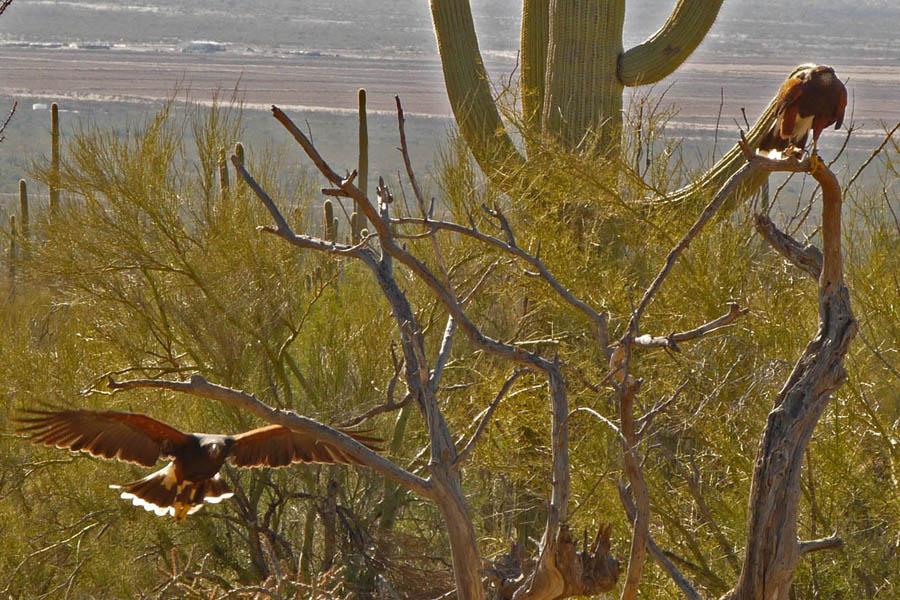HARRIS' HAWK
The Harris' Hawk is not found in Kentucky, but is native to the southwest region of the U.S, including Texas, New Mexico, Arizona and southern California. They prefer upland deserts dominated by saguaro cacti, arid mesquite and paloverde woodlands, or some juniper-oak habitat.
Harris' Hawks are extremely social raptors, and they are the only cooperative nesting raptor in North American. Individual breeding groups reside in and defend breeding territories. One alpha female forms a group with several males, and immature birds from previous clutches. All bring food back to the nest, resulting in a higher success rate for raising young. In most cases, only the alpha male and female feed and brood the young.
They often hunt cooperatively as well, using a flush and ambush, surprise pounces and relay attack methods. Kills are shared among the entire nesting group. As a result, Harris' Hawks are called the lions of the desert and resemble a pack of lions crowding around the kill to get their share. In winter, they perch in groups of up to a dozen. Sometimes, due to lack of perching space in the desert, they stand on another bird's shoulders, stacking 5-7 birds high in a cheerleader-like fashion. Their numbers are declining due to urban sprawl reducing their habitat.
They often hunt cooperatively as well, using a flush and ambush, surprise pounces and relay attack methods. Kills are shared among the entire nesting group. As a result, Harris' Hawks are called the lions of the desert and resemble a pack of lions crowding around the kill to get their share. In winter, they perch in groups of up to a dozen. Sometimes, due to lack of perching space in the desert, they stand on another bird's shoulders, stacking 5-7 birds high in a cheerleader-like fashion. Their numbers are declining due to urban sprawl reducing their habitat.
Harris Hawks are native to the Southwestern Desert here in the United States, they also possess some very distinct differences from our local Red-Tailed Hawks. First, the brow structure of her eyes is much deeper and acts like a visor to protect her eyes from the relentless desert sun. Similar in stature to a Red-Tail, she has quite different coloring, including white horizontal bands at both the base and tip of her tail. Additionally, Harris Hawk's talons are naturally longer than those found on our local hawks. The longer talons help this bird land and perch on large cacti without puncturing the foot pads.
Harris Hawks are also known as the Wolf Hawk due to their tendency to hunt in packs. The birds will flock together and descend on prey, often cornering it under ground cover. Then one or more of the birds will land and actively ground stalk the prey until it is captured. The flock then shares the meal together. A very social species, these birds also share a unique method in perching known as stacking. Stacking occurs when a bird lands on a cactus, the next bird will land on the shoulders of the first bird and perch there. So on and so forth until there is a stack of up to four birds.
Harris Hawks are also known as the Wolf Hawk due to their tendency to hunt in packs. The birds will flock together and descend on prey, often cornering it under ground cover. Then one or more of the birds will land and actively ground stalk the prey until it is captured. The flock then shares the meal together. A very social species, these birds also share a unique method in perching known as stacking. Stacking occurs when a bird lands on a cactus, the next bird will land on the shoulders of the first bird and perch there. So on and so forth until there is a stack of up to four birds.


